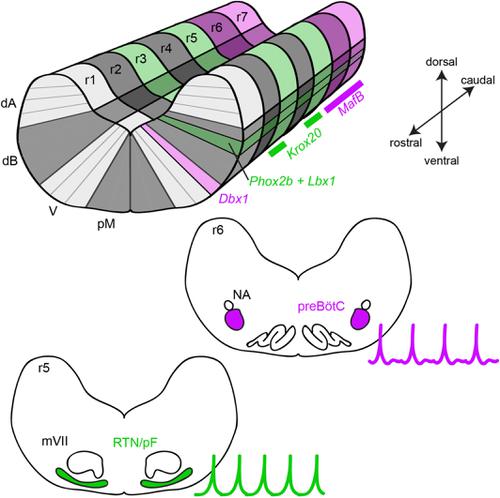当前位置:
X-MOL 学术
›
WIREs Mech. Dis.
›
论文详情
Our official English website, www.x-mol.net, welcomes your
feedback! (Note: you will need to create a separate account there.)
Development of the brainstem respiratory circuit.
WIREs Mechanisms of Disease ( IF 4.6 ) Pub Date : 2019-12-09 , DOI: 10.1002/wdev.366 Meike E van der Heijden 1, 2 , Huda Y Zoghbi 1, 2, 3, 4, 5
WIREs Mechanisms of Disease ( IF 4.6 ) Pub Date : 2019-12-09 , DOI: 10.1002/wdev.366 Meike E van der Heijden 1, 2 , Huda Y Zoghbi 1, 2, 3, 4, 5
Affiliation

|
The respiratory circuit is comprised of over a dozen functionally and anatomically segregated brainstem nuclei that work together to control respiratory rhythms. These respiratory rhythms emerge prenatally but only acquire vital importance at birth, which is the first time the respiratory circuit faces the sole responsibility for O2/CO2 homeostasis. Hence, the respiratory circuit has little room for trial‐and‐error‐dependent fine tuning and relies on a detailed genetic blueprint for development. This blueprint is provided by transcription factors that have specific spatiotemporal expression patterns along the rostral‐caudal or dorsal‐ventral axis of the developing brainstem, in proliferating precursor cells and postmitotic neurons. Studying these transcription factors in mice has provided key insights into the functional segregation of respiratory control and the vital importance of specific respiratory nuclei. Many studies converge on just two respiratory nuclei that each have rhythmogenic properties during the prenatal period: the preBötzinger complex (preBötC) and retrotrapezoid nucleus/parafacial nucleus (RTN/pF). Here, we discuss the transcriptional regulation that guides the development of these nuclei. We also summarize evidence showing that normal preBötC development is necessary for neonatal survival, and that neither the preBötC nor the RTN/pF alone is sufficient to sustain normal postnatal respiratory rhythms. Last, we highlight several studies that use intersectional genetics to assess the necessity of transcription factors only in subregions of their expression domain. These studies independently demonstrate that lack of RTN/pF neurons weakens the respiratory circuit, yet these neurons are not necessary for neonatal survival because developmentally related populations can compensate for abnormal RTN/pF function at birth.
中文翻译:

脑干呼吸回路的发展。
呼吸回路由十几个功能和解剖上分离的脑干核组成,它们共同控制呼吸节律。这些呼吸节律在产前出现,但仅在出生时才具有至关重要的意义,这是呼吸回路首次面对O 2 / CO 2的唯一责任稳态。因此,呼吸回路几乎没有试错依赖的微调空间,并且依赖详细的遗传蓝图进行开发。该蓝图由转录因子提供,这些转录因子在发育中的前体细胞和有丝分裂后神经元中,沿着发育中的脑干的喙尾或背腹轴具有特定的时空表达模式。对小鼠中这些转录因子的研究为呼吸控制的功能分离和特定呼吸核的至关重要性提供了重要见识。许多研究仅集中于两个呼吸道核,每个呼吸道核在产前均具有节律特性:preBötzinger复合体(preBötC)和梯形后核/面旁核(RTN / pF)。这里,我们讨论了指导这些细胞核发育的转录调控。我们还总结了证据,表明正常的preBötC发育对于新生儿存活是必要的,并且仅preBötC和RTN / pF都不足以维持正常的产后呼吸节律。最后,我们重点介绍了使用交叉遗传学评估转录因子仅在其表达结构域的亚区域中的必要性的几项研究。这些研究独立地证明,缺乏RTN / pF神经元会削弱呼吸回路,但是这些神经元对于新生儿的生存并不是必需的,因为与发育相关的人群可以弥补出生时的RTN / pF功能异常。并且仅preBötC和RTN / pF都不足以维持正常的产后呼吸节律。最后,我们重点介绍了使用交叉遗传学评估转录因子仅在其表达结构域的亚区域中的必要性的几项研究。这些研究独立地证明,缺乏RTN / pF神经元会削弱呼吸回路,但是这些神经元对于新生儿的生存并不是必需的,因为与发育相关的人群可以弥补出生时的RTN / pF功能异常。并且仅preBötC和RTN / pF都不足以维持正常的产后呼吸节律。最后,我们重点介绍了使用交叉遗传学评估转录因子仅在其表达结构域的亚区域中的必要性的几项研究。这些研究独立地证明,缺乏RTN / pF神经元会削弱呼吸回路,但是这些神经元对于新生儿的生存并不是必需的,因为与发育相关的人群可以弥补出生时的RTN / pF功能异常。
更新日期:2019-12-09
中文翻译:

脑干呼吸回路的发展。
呼吸回路由十几个功能和解剖上分离的脑干核组成,它们共同控制呼吸节律。这些呼吸节律在产前出现,但仅在出生时才具有至关重要的意义,这是呼吸回路首次面对O 2 / CO 2的唯一责任稳态。因此,呼吸回路几乎没有试错依赖的微调空间,并且依赖详细的遗传蓝图进行开发。该蓝图由转录因子提供,这些转录因子在发育中的前体细胞和有丝分裂后神经元中,沿着发育中的脑干的喙尾或背腹轴具有特定的时空表达模式。对小鼠中这些转录因子的研究为呼吸控制的功能分离和特定呼吸核的至关重要性提供了重要见识。许多研究仅集中于两个呼吸道核,每个呼吸道核在产前均具有节律特性:preBötzinger复合体(preBötC)和梯形后核/面旁核(RTN / pF)。这里,我们讨论了指导这些细胞核发育的转录调控。我们还总结了证据,表明正常的preBötC发育对于新生儿存活是必要的,并且仅preBötC和RTN / pF都不足以维持正常的产后呼吸节律。最后,我们重点介绍了使用交叉遗传学评估转录因子仅在其表达结构域的亚区域中的必要性的几项研究。这些研究独立地证明,缺乏RTN / pF神经元会削弱呼吸回路,但是这些神经元对于新生儿的生存并不是必需的,因为与发育相关的人群可以弥补出生时的RTN / pF功能异常。并且仅preBötC和RTN / pF都不足以维持正常的产后呼吸节律。最后,我们重点介绍了使用交叉遗传学评估转录因子仅在其表达结构域的亚区域中的必要性的几项研究。这些研究独立地证明,缺乏RTN / pF神经元会削弱呼吸回路,但是这些神经元对于新生儿的生存并不是必需的,因为与发育相关的人群可以弥补出生时的RTN / pF功能异常。并且仅preBötC和RTN / pF都不足以维持正常的产后呼吸节律。最后,我们重点介绍了使用交叉遗传学评估转录因子仅在其表达结构域的亚区域中的必要性的几项研究。这些研究独立地证明,缺乏RTN / pF神经元会削弱呼吸回路,但是这些神经元对于新生儿的生存并不是必需的,因为与发育相关的人群可以弥补出生时的RTN / pF功能异常。











































 京公网安备 11010802027423号
京公网安备 11010802027423号